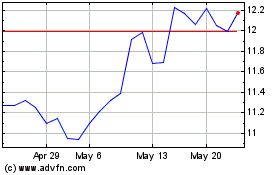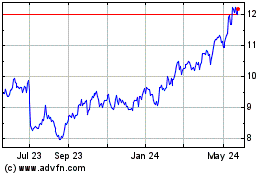Big Chinese Banks Issue New Yuan-Denominated Debt In U.S.
20 May 2016 - 8:50AM
Dow Jones News
Two of China's largest banks are issuing new local currency debt
in the U.S., offering attractive yields for investors willing to
take some currency risk.
Industrial and Commercial Bank of China Ltd., the world's
largest bank by assets, said it plans on Friday to raise 500
million yuan ($76 million) through 31-day certificates of deposit
in the U.S. that will yield 2.6%.
Agricultural Bank of China Ltd., the third-largest bank in the
world, this week sold a 117 million yuan one-year bill that yields
3.35%. Both issues came at a significant premium to the 0.621%
yield on the one-year U.S. Treasury bill.
But the yuan-denominated debt could pay out less if the currency
falls in value. Federal Reserve officials last month discussed the
possibility of raising interest rates at their June policy meeting,
according to minutes from the April meeting released on Wednesday.
A rate increase could cause the yuan to weaken against the
dollar.
China's 3% devaluation in August sparked a selloff in
yuan-denominated bonds, driving up interest rates in the offshore
market, also known as the dim sum market.
The new offerings will test demand for Chinese debt in local
currency, the first issued by any Chinese bank in the U.S. since
last year.
China's one-month interbank rate is currently 2.84%, which means
some Chinese banks can borrow at better rates in the U.S. and other
foreign markets than at home.
The debt also promotes the use of the yuan abroad, one of the
conditions set by the International Monetary Fund when it said last
year it would add the Chinese currency to its basket of reserve
currencies. The IMF's inclusion of the yuan is a step toward making
the currency fully convertible.
Issuing yuan-denominated bonds under favorable market conditions
offers "a new way of obtaining low-cost funding for U.S.-based
Chinese banks and other institutions," said Wang Zhongkun, head of
treasury at Agricultural Bank of China's New York branch. Standard
Chartered Bank was the sole manager for the issuance.
Banks and institutional investors in Asia and Europe, where
interest rates have fallen below zero in many places, are among the
largest buyers of the Chinese debt, according to people who are
familiar with the deals. These short-term instruments are also used
by banks that transact with China to hedge their exposure,
investors say.
While Chinese banks have sold yuan-denominated debt in the U.S.
previously, the new issue will be the first to settle in accounts
in the U.S. Industrial and Commercial Bank Chairman Jiang Jianqing
said that transfer of cash in the U.S. represented a "milestone" in
terms of the yuan's use abroad.
The $126 billion offshore yuan bond market began to take off in
2010 after authorities loosened restrictions and allowed foreign
entities to issue yuan-denominated bonds.
Total issuance of dim-sum bonds by Chinese firms plunged 81% in
2015 to $5.1 billion, the lowest level since 2010, according to
Dealogic data. This year, there was only one Chinese issue until
recently.
As a result, offshore yuan deposits and bonds outstanding fell
sharply, dealing a blow to China's push for wider yuan usage. In
February, the global share by value of payments made in the yuan
fell to 1.76%, the lowest level since October 2014. That level grew
slightly to 1.88% in March but was still down from end-2015's
2.31%, according to SWIFT.
Both of the Chinese banks are among the 22 members that have
recently formed the Working Group on U.S. RMB Trading and Clearing.
The group, chaired by former New York City Mayor Michael Bloomberg,
aims "to develop and expand the trading, clearing and settlement"
of yuan in the U.S., according to the group's website.
Write to Carolyn Cui at carolyn.cui@wsj.com
(END) Dow Jones Newswires
May 19, 2016 18:35 ET (22:35 GMT)
Copyright (c) 2016 Dow Jones & Company, Inc.
Agricultural Bank of China (PK) (USOTC:ACGBY)
Historical Stock Chart
From Jan 2025 to Feb 2025

Agricultural Bank of China (PK) (USOTC:ACGBY)
Historical Stock Chart
From Feb 2024 to Feb 2025
